 There's no jealousy like a femme fatale's jealousy. 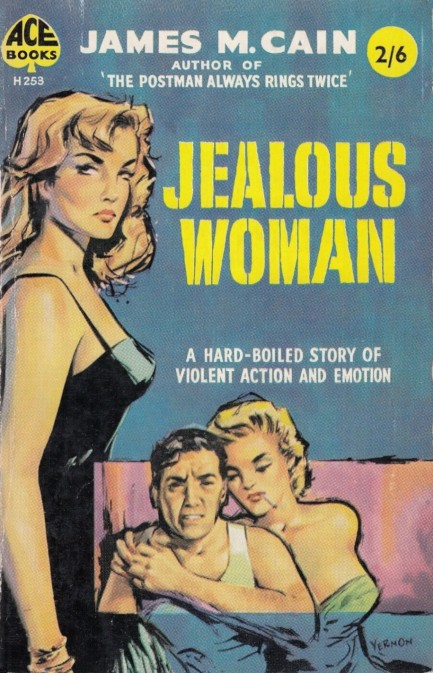
It's amazing how much easier James M. Cain makes writing seem than scores of other authors. His 1950 novel Jealous Woman starts at a gallop. Here's the first line: At the desk, when they said she was in 819, I knew hubby or pappy or somebody was doing all right by their Jane, because 19 is the deluxe tier at the Washoe-Truckee, one of our best hotels here in Reno, and you don’t get space there for buttons. And just like that we're off. Cain gives readers ambitious insurance man Ed Horner of General Pan-Pacific Insurance of California. Horner lives, works, and parties in Reno, where unhappy marrieds migrate to be freed from their nuptial bonds. He gets involved in a complex divorce/annulment scheme between Jane Delavan, her rich husband, Jane's ex-husband, and his current wife. Yes, it's a bit complicated, but a messy murder uncomplicates it a little. At least for readers. For Horner, things get weird. Jealous Woman isn't Cain's best, but it's still a slice of devious fun worth reading, and this Ace version with John Vernon cover art is the edition to buy if you can. 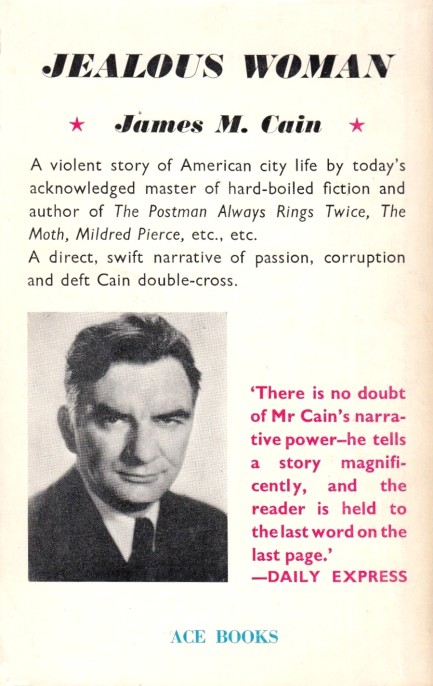
 1959 flood thriller proves that even during a natural disaster money, booze, and women are all that matter. 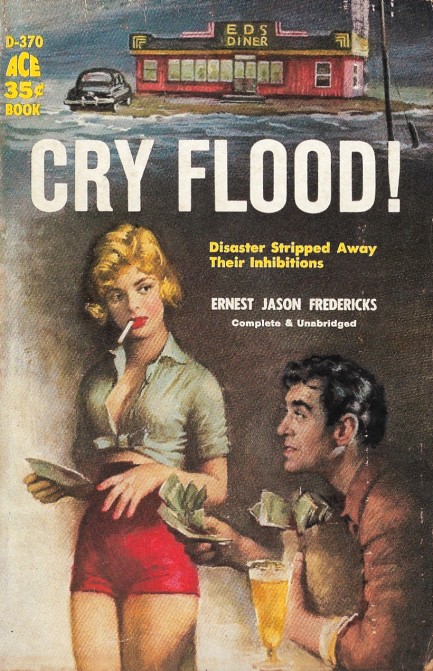
Ernest Jason Fredericks', aka Paul Ernst's 1959 novel Cry Flood!, for which see an Ace paperback edition above with nice art by George Ziel, is a thriller in the flood/hurricane sub-genre on which we've gotten hooked in recent years. We've read entires from John D. MacDonald, Theodore Pratt, Malcolm Douglas, and others. It seems as though the close quarters and ticking clock aspects built into disaster settings bring out the best in authors.
In Cry Flood! Fredericks sets the action in a New Jersey diner perched on high land as two hurricanes to the south and unseasonable rain in the region bring the nearby river to the record crest of a 1936 flood—then beyond. Converging on the diner are a bank-phobic miser carrying twenty-six thousand dollars, four married couples, and two criminals who catch wind of the money and intend to steal it. The problem is the flood waters rise too high for anyone to leave, which means the crooks must bide their time, prompting them to spend it terrorizing those with whom they're trapped.
In Fredericks' hands, the two bad men are synonymous with the flood, implacable and unavoidable, forcing the couples to face their fears and admit their failings before death sweeps them away. Or not—but only if they're brave and lucky. It was quite well done, and consistently enjoyable. For our money, the best of the flood/hurricane lot so far has been John and Ward Hawkins' A Girl, a River, and a Man, but Cry Flood! held its own in what has continued to be fertile pop fiction territory.

 Not to complain, oh great master thief, but all you've stolen lately has been booze money out of my purse. 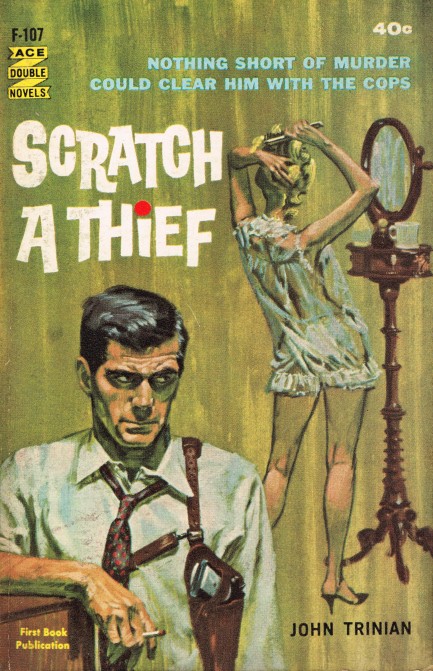 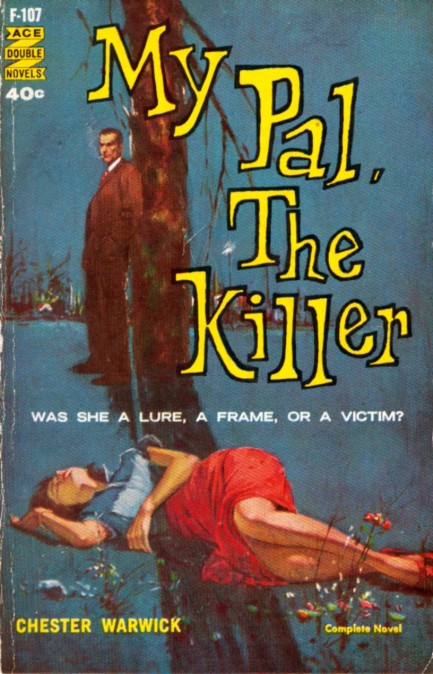
The thieving business runs hot and cold, and it reaches freezing depths when your girlfriend starts giving you a hard time about your earnings. Actually, let's not restrict that to thieving. It's true whatever your chosen field happens to be. John Trinian's Scratch a Thief was published in 1961 as an Ace Double Novel with Chester Warwick's My Pal, The Killer. Scratch a Thief later became a movie with Alain Delon and Ann-Margret in the leads, and at that time was retitled Once a Thief and credited to Trinian's pseudonym Zekail Marko. In reality, he was neither Trinian nor Marko, but Marvin Schmoker. So, you can understand the name changes. High school must have been hell for the guy. We haven't read him yet but we'll get around to it. And maybe to Chester Warwick too. You never know. But we'll for sure get around to the movie.
 *sigh* That was really unpleasant. I don't know why, but I always assumed it was just a euphemism. 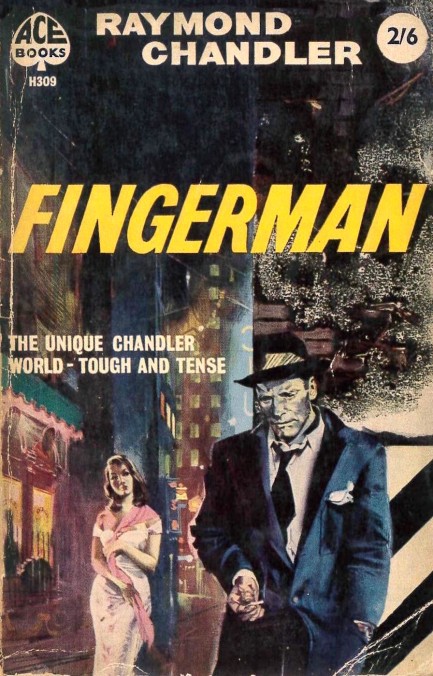
This cover for Raymond Chandler's 1960 story collection Fingerman was painted by an uncredited artist, but once again we're thinking it's Sandro Symeoni on the brush. 1958 to 1960 was when he was working extensively with Ace Books, and this illustration is very much in his style, as we've discussed here and here. The book consists of four offerings: the stories “Finger Man,” which was first published in Black Mask in October 1934, “The King in Yellow,” from the March 1938 issue of Dime Detective Magazine, and “Pearls Are a Nuisance,” also from Dime Detective Magazine, coming in April 1939. The last piece is a Chandler essay titled, “The Simple Art of Murder.” A couple of the aforementioned tales also appeared in Five Sinister Characters. All the stories are good, but we talked about “The King in Yellow” in a bit more detail a while back, so if you're interested feel free to check here.
 At least we're still in love after all these years, honey. You're in love with a waitress, and I'm in love with a cabana boy. 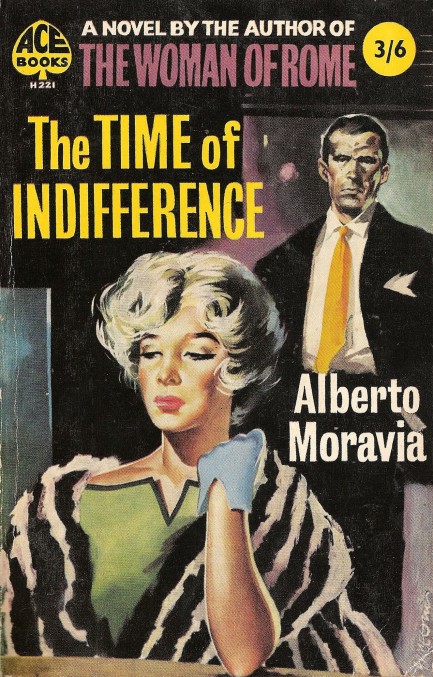
We're back to Italian illustrator Sandro Syemoni today, who we consider a genius in his field. Above you see his cover for Ace Books' 1958 edition of Alberto Moravia's The Time of Indifference, which was originally published in 1929 as Gli indifferenti. We gather it was quite a racy book and it sold out in weeks. Ace, as we've mentioned before, repackaged a lot of literary fiction with newly provocative covers. If you're going to go that route, Symeoni was close to the best. See what we mean here and here. And check some of his poster work here.
 If you can't count on on family, who can you count on? 
For a few years we've been meaning to get back to Fletcher Flora, and finally we've done it. Above you see his half of an Ace Double novel—Killing Cousins. The book is about a spoiled suburban wife who shoots her husband, then calls on one of her lovers—her husband's cousin—for help in covering up the crime. Cousin Quincy is known to be a genius, and he relishes the challenge of outwitting the cops. Generally, he does fine. It's the people around him he can't count on, including his cousin Fred, who, because he doesn't know about the murders and thus doesn't realize the importance of what he's asked to do, botches his crucial task. It's only the first of many problems. Flora has a unique voice, no doubt about it. Some might find it too self-conscious, but we liked it. Check out the two examples below:
When she had first wakened and remembered what had happened, she had been very frightened and had felt a necessity to do something immediately, no matter what, but then it had occurred to her that it all might be nothing more than a bad dream, which she sometimes had, and so she had gone into Howard’s bedroom to make sure, one way or the other, and it had turned out not to be a dream at all, for there Howard was on the floor.
Heretofore, cousin Fred’s approach to women had been direct and simple, even somewhat primitive, and if the approach was no more than moderately effective on the whole, it had at least left him unfettered and uncluttered, free alike of uncomfortable commitments and emotional hangovers. If a chick would, she would. If a chick wouldn’t, she wouldn’t. And if she wouldn’t, to hell with her. That, in brief, was cousin Fred’s position.
Flora's writing feels like it comes from someone who knows exactly what he's trying for and absolutely achieves it. There are no missteps. Plotwise, the murderous wife, apart from shooting her husband, is mostly a bystander. The success or failure of the cover-up rests entirely in cousin Quincy's hands, and he's confident to a fault. As holes develop in his clever plot, he's forced to improvise, and ultimately Flora boils the drama down to how fast Quincy can think, and whether the police are competent investigators. Speaking of which, we'll give Flora credit for one of the great cop names of all time—Elgin Necessary. We think Killing Cousins is a necessary read based on its unusual style alone.
By comparison, John Crieghton's, aka Joseph L. Chadwick's, The Blonde Cried Murder is much more what you'd expect from a mid-century crime novel. The set-up sounds like the beginning of a joke: a woman walks into a detective's office. We like books that start that way. We think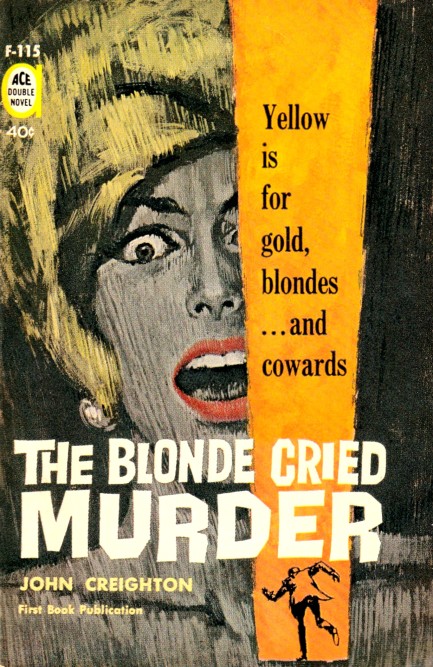 of such authors the way we think of musicians who decide to cover a classic. It's been done before, but not in that exact style. So, a woman walks into downtrodden private dick Ed Donovan's office and asks him to find a missing person—her husband, who may have fled to avoid the police. of such authors the way we think of musicians who decide to cover a classic. It's been done before, but not in that exact style. So, a woman walks into downtrodden private dick Ed Donovan's office and asks him to find a missing person—her husband, who may have fled to avoid the police.
From there the tale continues in classic directions: Donovan drinks way too much, he's soon on the hook for a murder he didn't commit, there's money that needs to be found, etc. And of course, romance rears its inconvenient head. The book is an unusual flipside to Killing Cousins because of how standard it is by comparison, but it's worth a read. Not that you have a choice. To read one means to buy both. Some Ace doubles can cost a lot online, but this one is usually reasonable. There are two copyrights, 1960 for Flora and 1961 for Creighton, and the cover art for both is uncredited.
 Whatever floats your corpse. 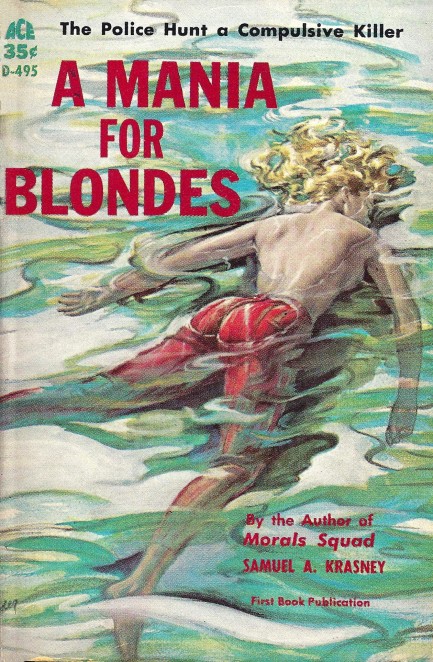
Art by Paul Rader fronts this copy of Samuel A. Krasney's A Mania for Blondes, a police proceedural dealing with two women drowned in Philadelphia's Delaware River, and the investigation to bring a killer to justice. The protagonist here is vice detective Ben Krahmer, who learns that both victims appeared in nudie reels. The clues lead down the rabbit hole of illicit porn and toward a mysterious suspect witnesses think looks like Zorro—but who Krahmer soon realizes may be a member of Pennsylvania's traditionally garbed Dutch community. Procedurals sometimes—as is the case here—fail to provide deep characterizations, but the mechanics of the investigation are interesting. Krasney constantly refers to his protagonist as “the Morals man”—capital M—which we found weird, but we thought this outing was solid overall and we liked the Zorro imagery. Even so, we probably won't go looking for more from Krasney unless we run across him cheap. There are, after all, so many paperbacks, and so little time.
 Beauty is easy to love. Ugly takes unresolved psychological issues. 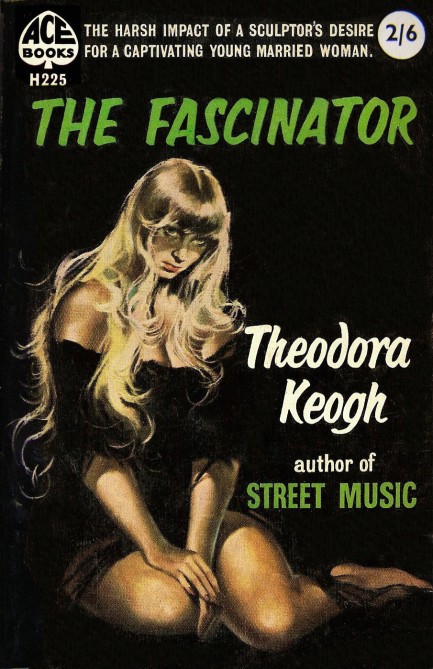
Spouses who cheat usually don't do so because their fling is more attractive than their partner. We learned this years ago from a widely noted survey of cheaters. What attracts them is that the person they desire is more exciting. Theodora Keogh's 1954 novel The Fascinator encapsulates this idea. It's about a woman's attraction to a man who's more exciting than her husband. The other man, Zanic, is ugly due to a congenital condition that made his brows and ears grow so he looks like an ape, and he's also overweight. But no matter—he's a sculptor and an elegant speaker and all the rest, so the story, as it develops, follows whether the main character Ellen will actually cheat with this persistent and somewhat creepy ogre of a man who she finds more exciting than her handsome but normal husband. It's not the type of book we usually read, but blame the cover art for that. It drew us because we thought it might be another Sandro Symeoni effort for Ace Books. It's uncredited, but we suspect Sandro's brush. Why? Look here. In any case The Fascinator is well written and thoughtful.
 Anything could happen there and it usually did. 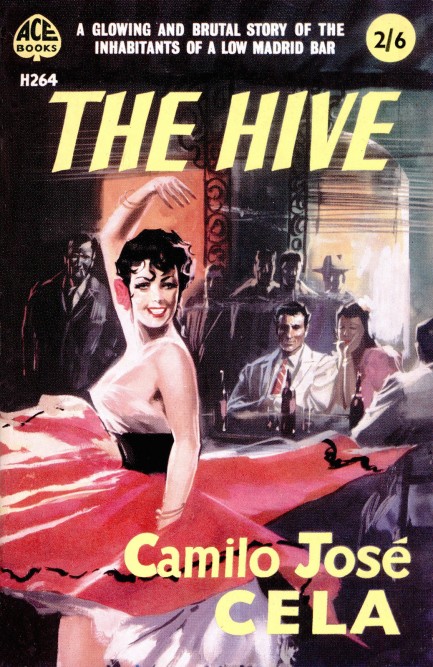
We're drawn to books about places we know, so Camilo José Cela's The Hive was a natural. Originally published in 1950 and titled La colmena, the tale is largely set in a Madrid bar known as Doña Rosa's Café. There are also scenes set in apartments, streets, and other cafés, as Cela explores the lives of more than three-hundred characters in brief sketches, slowly weaving these warp and weft strands into a tapestry that ultimately represents a single character—Madrid circa 1943. Maybe that doesn't sound thrilling, but we liked it. Cela was economical yet vivid, like here, at closing time for the café:
Within half an hour the café will be empty. It will be like a man who has suddenly lost his memory.
And here, about a boy who survives by singing on the street:
He is too young in years for cynicism—or resignation—to have slashed its mark across his face, and therefore it has a beautiful, candid stupidity, the expression of one who understands nothing of anything that happens. For [him] everything that happens is a miracle: he was born by a miracle, he eats by a miracle, has lived by a miracle, and has the strength to sing by pure miracle.
Cela was a fascist, a supporter of Francisco Franco's dictatorship. His beliefs came with contradictions, for example he worked as a censor for the government, was himself banned so that The Hive had to be published first in Argentina, yet remained loyal to the regime that had financially and reputationally harmed him. He even became an informer. In Cela's writing there's humor, but also coldness, a sense of observing small and pathetic people. For someone born into material comfort in a Spain where many families retain unearned wealth for hundreds of years, his subtle judgements came across to us as cruel, the product of a person who looked closely at everyone but himself. The book isn't overtly political, though, which makes it easier to focus on the skill that eventually won him a Nobel Prize.
The edition you see here is from Ace Books in 1959 with an uncredited cover. We went back and forth on this artist. We want to say it's Sandro Symeoni, but we don't have enough cred to make that call definitively. It looks like some of the items he painted, but publishing companies sometimes sought art of similar styles, or directed illustrators to produce something similar to what another artist had provided. During the late 1950s and early ’60s Ace Books had many covers in this general style. That said, compare the close-ups below. The first is from the above cover, and the rest are from confirmed Symeonis. If The Hive wasn't painted by the same person, then whoever did paint it went beyond merely working in a similar style—he was a thief. 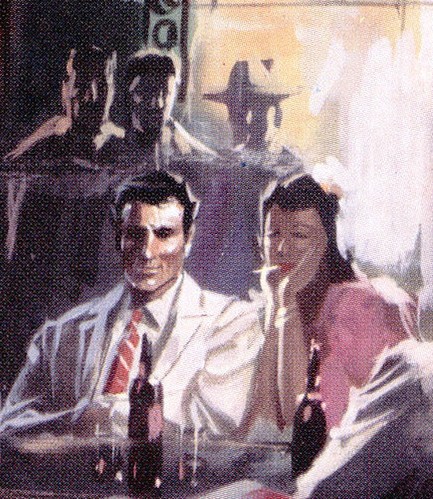 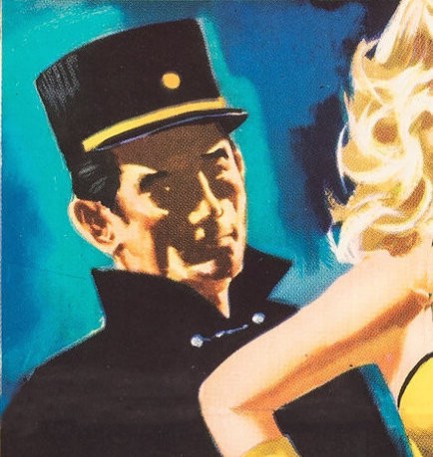 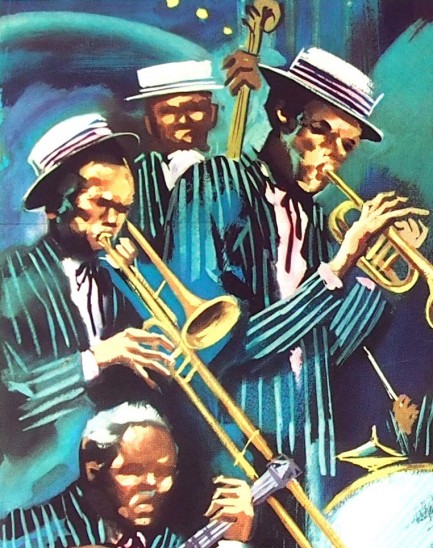 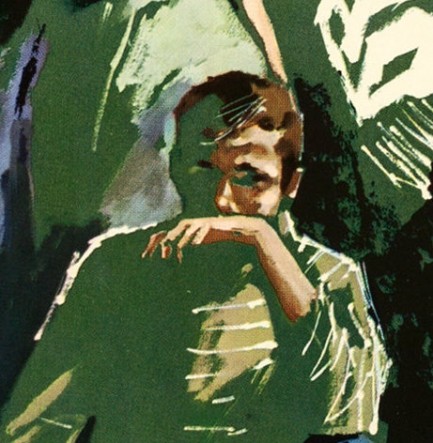 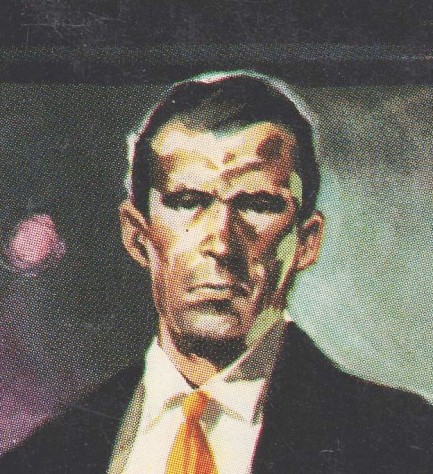
 I'll have to go to confession later for thinking this, but my religion could use a few sweaty writhing chicks. 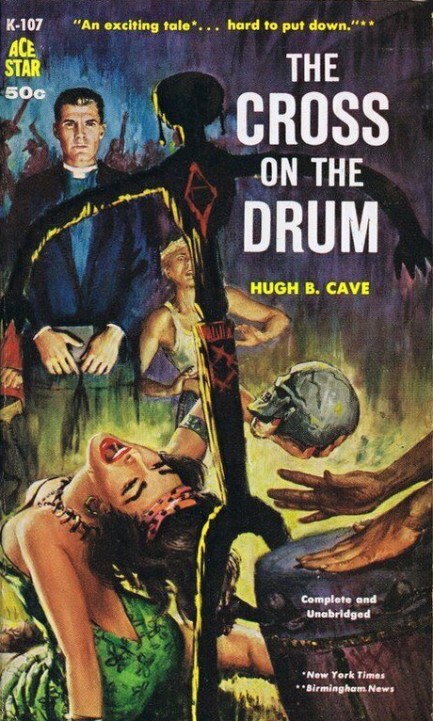
We know Hugh B. Cave as a horror writer, so when we saw this wild Samson Pollen cover for his 1959 novel The Cross on the Drum we were looking forward to some dark and scary stuff fit for the Halloween season. Unfortunately, Cave plays it straight—or as straight as you can in a voodoo novel. Basically, it's a variation on the standard South Seas tale, except set in the Caribbean on a small island called Ile du Vent, and involving a missionary who wants to civilize the locals. The book is absolutely fine aside from its built-in cultural snobbery, but it never had the weight and menace we seek from a novel of this type. In the end, how you assess it might hinge on your own beliefs. If you're a Christian you'll probably see it as a thrilling tale of moral uplift in which Jesus outshines the false gods of santería, but if you're a non-believer you'll probably see a flawed novel-length discussion of whether one primitive superstition is inherently better than another. Take a side and discuss.

|
 |

The headlines that mattered yesteryear.
1939—Batman Debuts
In Detective Comics #27, DC Comics publishes its second major superhero, Batman, who becomes one of the most popular comic book characters of all time, and then a popular camp television series starring Adam West, and lastly a multi-million dollar movie franchise starring Michael Keaton, then George Clooney, and finally Christian Bale. 1953—Crick and Watson Publish DNA Results
British scientists James D Watson and Francis Crick publish an article detailing their discovery of the existence and structure of deoxyribonucleic acid, or DNA, in Nature magazine. Their findings answer one of the oldest and most fundamental questions of biology, that of how living things reproduce themselves. 1967—First Space Program Casualty Occurs
Soviet cosmonaut Vladimir Komarov dies in Soyuz 1 when, during re-entry into Earth's atmosphere after more than ten successful orbits, the capsule's main parachute fails to deploy properly, and the backup chute becomes entangled in the first. The capsule's descent is slowed, but it still hits the ground at about 90 mph, at which point it bursts into flames. Komarov is the first human to die during a space mission. 1986—Otto Preminger Dies
Austro–Hungarian film director Otto Preminger, who directed such eternal classics as Laura, Anatomy of a Murder, Carmen Jones, The Man with the Golden Arm, and Stalag 17, and for his efforts earned a star on Hollywood's Walk of Fame, dies in New York City, aged 80, from cancer and Alzheimer's disease. 1998—James Earl Ray Dies
The convicted assassin of American civil rights leader Martin Luther King, Jr., petty criminal James Earl Ray, dies in prison of hepatitis aged 70, protesting his innocence as he had for decades. Members of the King family who supported Ray's fight to clear his name believed the U.S. Government had been involved in Dr. King's killing, but with Ray's death such questions became moot.
|

|
|

It's easy. We have an uploader that makes it a snap. Use it to submit your art, text, header, and subhead. Your post can be funny, serious, or anything in between, as long as it's vintage pulp. You'll get a byline and experience the fleeting pride of free authorship. We'll edit your post for typos, but the rest is up to you. Click here to give us your best shot.

|
|















 of such authors the way we think of musicians who decide to cover a classic. It's been done before, but not in that exact style. So, a woman walks into downtrodden private dick Ed Donovan's office and asks him to find a missing person—her husband, who may have fled to avoid the police.
of such authors the way we think of musicians who decide to cover a classic. It's been done before, but not in that exact style. So, a woman walks into downtrodden private dick Ed Donovan's office and asks him to find a missing person—her husband, who may have fled to avoid the police.

















































































